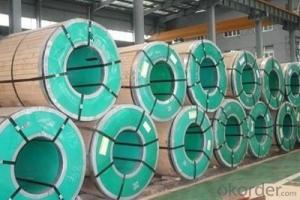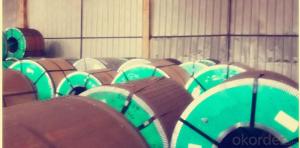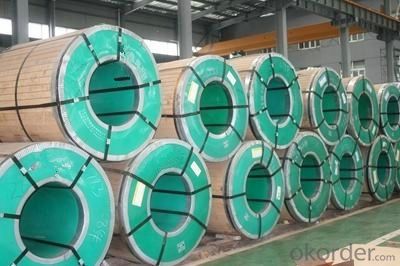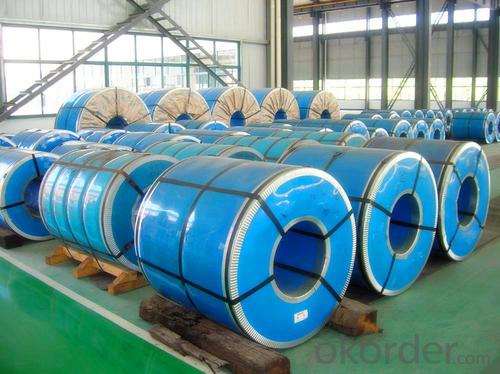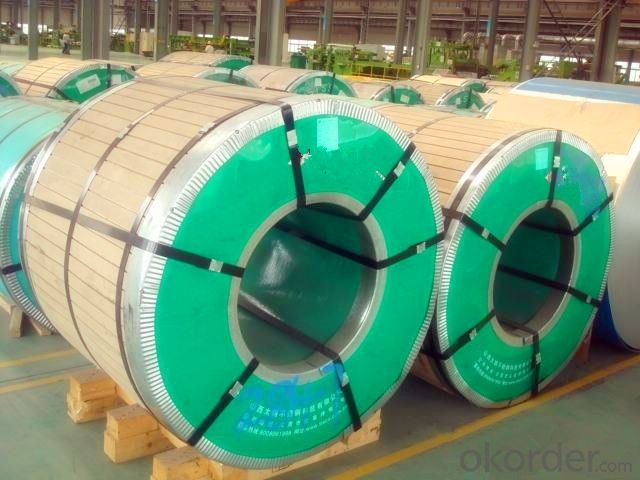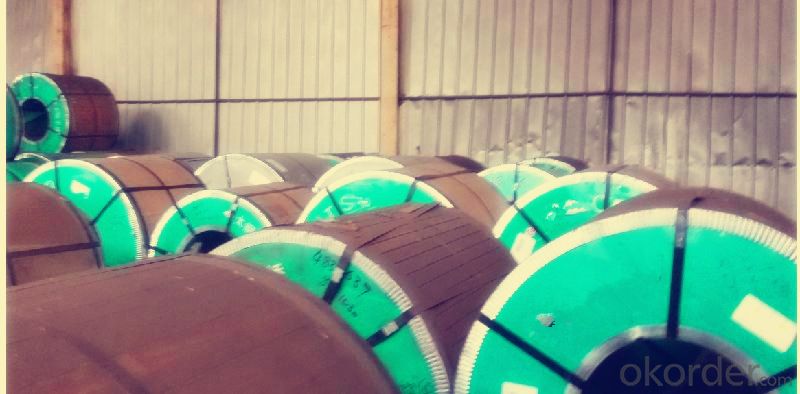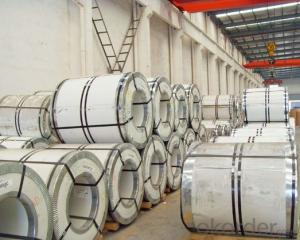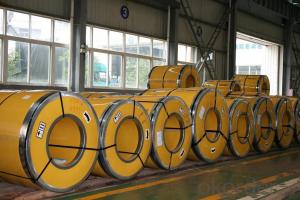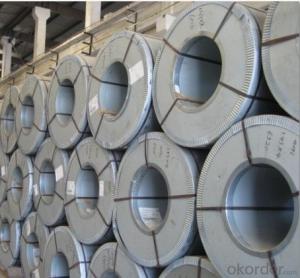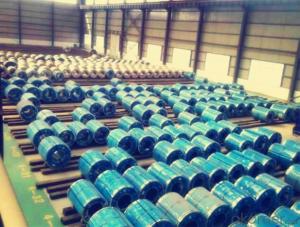Stainless Steel Coil 304 Hot/Cold Rolled 2B/BA/NO.1
- Loading Port:
- Guangzhou
- Payment Terms:
- TT OR LC
- Min Order Qty:
- 100 m.t.
- Supply Capability:
- 20000 m.t./month
OKorder Service Pledge
OKorder Financial Service
You Might Also Like
Hot Rolled Stainless Steel Coil 304
Annealing and Pickling No.1 Finish
Stainless steel is a production which not easy rust,acid resistance and corrosion resistance,so it is widely
used in light industry,heavy industry,daily necessities and the decoration industry.
Hot Rolled Stainless Steel Coil 304 Specifications
1.surface:NO.1
2.standard:JIS, AISI, GB
3.width: 0.55m, 0.65m, 1.0m, 1.22m, 1.5m, 2m or requirement
Hot Rolled Stainless Steel Coil 304 Chemical Composition:
(%):C=0.07, Mn=2.00, P=0.045, S=0.030, Si=0.075, Cr=17.5-19.5, Ni=8.0-10.5, N=0.10
Hot Rolled Stainless Steel Coil 304 Physical Properties
Tensile strength σb (MPa) ≥ 520
the conditions yield strength σ0.2 (MPa) ≥ 205,
elongation δ5 (%) ≥ 40
Reduction of ψ (%) ≥ 50,
hardness: ≤ 187
HB; ≤ 90
HRB; ≤ 200H
- Q: What is the price range of stainless steel strips?
- The cost of stainless steel strips can fluctuate based on several factors, including the grade of stainless steel, strip thickness and width, and the quantity ordered. Typically, prices for stainless steel strips can begin at approximately $1 per pound and reach $10 or higher per pound. Nevertheless, it is crucial to acknowledge that these prices are rough estimates and subject to alteration based on market circumstances and supplier rates. It is advisable to reach out to stainless steel suppliers or manufacturers for precise and current pricing details tailored to specific needs.
- Q: Are stainless steel strips suitable for dairy tanks?
- Yes, stainless steel strips are suitable for dairy tanks. Stainless steel is a popular choice for dairy tanks due to its excellent corrosion resistance, hygienic properties, and ease of cleaning. It is also resistant to bacterial growth and does not react with milk or other dairy products, making it a safe and reliable material for dairy tank construction.
- Q: Are 111 stainless steel strips suitable for cryogenic storage containers?
- Cryogenic storage containers can effectively utilize 111 stainless steel strips. This type of austenitic stainless steel possesses exceptional resistance to corrosion and high temperatures. Moreover, it is known for its durability and strength. These properties render it suitable for cryogenic storage containers, which are specifically designed to withstand extremely low temperatures. The 111 stainless steel strips exhibit resilience to low temperatures, maintaining their structural integrity without becoming brittle. Furthermore, their corrosion resistance ensures the containers remain in optimal condition, even in moist cryogenic environments. Ultimately, incorporating 111 stainless steel strips into cryogenic storage containers proves to be a dependable and efficient decision.
- Q: What are the factors affecting the creep resistance of 111 stainless steel strips?
- The factors affecting the creep resistance of 111 stainless steel strips can be numerous and include: 1. Composition: The chemical composition of the stainless steel strips, including the presence of alloying elements such as chromium, nickel, and molybdenum, can significantly impact its creep resistance. Higher levels of these elements generally improve resistance to creep deformation. 2. Microstructure: The microstructure of the stainless steel strips, including the size, distribution, and stability of the various phases and grain boundaries, can influence creep resistance. A fine and uniform grain structure with minimal grain boundary sliding is desirable for improved creep resistance. 3. Temperature: Creep resistance decreases as temperature increases. Higher temperatures promote the diffusion of atoms, resulting in increased creep deformation. Therefore, stainless steel strips intended for high-temperature applications should be designed to withstand the specific temperature range without significant creep deformation. 4. Stress level: The applied stress or load on the stainless steel strips can affect creep resistance. Higher stress levels can accelerate creep deformation, leading to reduced creep resistance. It is important to consider the stress levels that the strips will be subjected to during their intended service life. 5. Time: Creep resistance is time-dependent, meaning that the longer the stainless steel strips are subjected to a constant load or stress, the more susceptible they are to creep deformation. Therefore, the duration of the applied load or stress should be considered when assessing the creep resistance of 111 stainless steel strips. 6. Surface condition: The condition of the stainless steel strip's surface, including the presence of defects, scratches, or surface roughness, can influence its creep resistance. A smooth and defect-free surface can help minimize stress concentration and reduce the likelihood of localized creep deformation. 7. Environmental factors: The presence of aggressive environments, such as high-temperature gases or corrosive substances, can affect the creep resistance of stainless steel strips. Corrosion or oxidation can lead to the degradation of the material, reducing its creep resistance. 8. Heat treatment: The heat treatment process used during the manufacturing of stainless steel strips can significantly impact their microstructure and, consequently, their creep resistance. Proper heat treatment procedures, including annealing, quenching, and tempering, can optimize the material's creep resistance properties. It is important to note that these factors are interrelated and should be considered together when evaluating the creep resistance of 111 stainless steel strips.
- Q: How are stainless steel strips made?
- Stainless steel strips are typically made through a process called cold rolling. This involves passing a large coil of stainless steel through a series of rollers that gradually reduce its thickness. The steel strip is then annealed, which involves heating it and slowly cooling it to enhance its strength and corrosion resistance. Finally, the strip is cut into desired lengths and finishes, ready to be used in various applications such as automotive, construction, or manufacturing industries.
- Q: Are 111 stainless steel strips suitable for electrical conductivity applications?
- No, 111 stainless steel strips are not suitable for electrical conductivity applications. Stainless steel is known for its excellent corrosion resistance and strength, but it is not a good conductor of electricity. For electrical conductivity applications, metals like copper, aluminum, or silver are preferred due to their high conductivity properties.
- Q: Can stainless steel strips be used in marine applications?
- Indeed, the utilization of stainless steel strips in marine applications is possible. The exceptional corrosion resistance of stainless steel renders it a perfect choice for marine settings, where it endures constant exposure to saltwater and moisture. In marine applications, such as boat hardware, marine fittings, and structural components, stainless steel strips are frequently employed. These strips are specifically engineered to endure the rigorous conditions of the sea, including elevated levels of salt, humidity, and UV exposure. Moreover, stainless steel strips exhibit remarkable strength and durability, guaranteeing their ability to endure the challenging conditions of marine environments for an extended duration.
- Q: What are the common uses of stainless steel strips in the aerospace structural components?
- Stainless steel strips find various uses in aerospace structural components due to their unique properties and advantages. Some common uses include: 1. Structural Support: Stainless steel strips are often used in the construction of aircraft frame structures, where they provide strength and stability. They are commonly utilized in wing spars, fuselage frames, and other load-bearing components. 2. Fasteners and Connectors: Stainless steel strips are ideal for manufacturing fasteners and connectors used in aerospace applications. Their high tensile strength, corrosion resistance, and ability to withstand extreme temperatures make them suitable for securing and joining different structural elements. 3. Exhaust Systems: Aerospace engines generate high temperatures and corrosive gases, making stainless steel strips an excellent choice for constructing exhaust systems. They can withstand the heat and corrosive environment, ensuring the longevity and reliability of the system. 4. Fuel and Hydraulic Lines: Stainless steel strips are often used in the fabrication of fuel and hydraulic lines within aircraft. Their resistance to corrosion and ability to handle high pressures make them a reliable choice for transporting essential fluids throughout the aircraft. 5. Heat Shields: In aerospace applications, stainless steel strips are utilized in the construction of heat shields. These shields protect sensitive components from high temperatures generated by engines, allowing them to function properly and prolonging their lifespan. 6. Interior Components: Stainless steel strips are also employed in the manufacturing of interior components such as cabin fittings, seat structures, and galley equipment. Their aesthetic appeal, durability, and resistance to wear and tear make them suitable for enhancing the overall passenger experience and ensuring safety. Overall, stainless steel strips are widely used in aerospace structural components due to their strength, corrosion resistance, ability to withstand high temperatures, and reliability. Their versatility and performance make them an essential material in the aerospace industry.
- Q: Are stainless steel strips suitable for brewery equipment?
- Indeed, brewery equipment can greatly benefit from the utilization of stainless steel strips. Renowned for its impeccable corrosion resistance, durability, and hygienic attributes, stainless steel stands as a favored material choice. Such strips may be employed in crafting a multitude of brewery equipment components like fermentation tanks, brewhouses, piping, and fittings. Thanks to its remarkable resistance against rust and corrosion, the equipment remains untainted, maintaining the utmost sanitation throughout the brewing process. Furthermore, stainless steel's effortless cleaning and upkeep are of paramount importance in guaranteeing the beer's quality and consistency.
- Q: How are stainless steel strips manufactured?
- Stainless steel strips are manufactured through a process called hot rolling, where stainless steel ingots are heated and passed through a series of rolling mills to reduce their thickness and shape them into long, thin strips. The strips are then annealed to relieve any stresses and improve their mechanical properties. Finally, they undergo pickling and passivation treatments to remove impurities and enhance corrosion resistance.
Send your message to us
Stainless Steel Coil 304 Hot/Cold Rolled 2B/BA/NO.1
- Loading Port:
- Guangzhou
- Payment Terms:
- TT OR LC
- Min Order Qty:
- 100 m.t.
- Supply Capability:
- 20000 m.t./month
OKorder Service Pledge
OKorder Financial Service
Similar products
Hot products
Hot Searches
Related keywords
